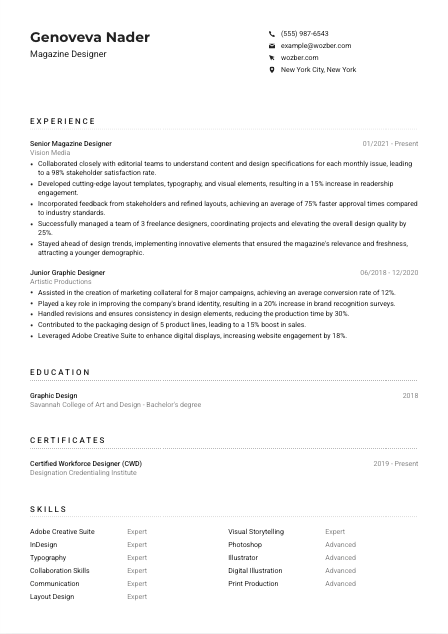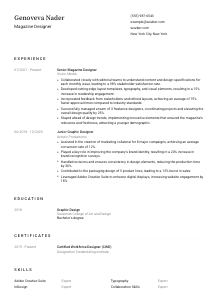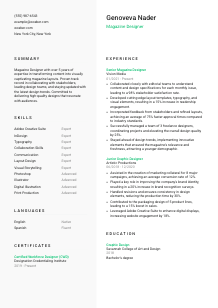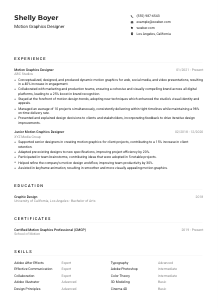Magazine Designer Resume Example
Designing spreads, but your resume seems underexposed? Dive into this Magazine Designer resume example, styled with Wozber free resume builder. Discover how to showcase your layout finesse to match job profiles, ensuring your career gets the glossy, full-spread treatment it deserves!

How to write a Magazine Designer Resume?
Hello, aspiring Magazine Designer! In the bustling world of print and digital media, your resume is your personal exhibit - an artistic testament to your design prowess. But how do you ensure it captures the essence of your creativity yet satisfies the scrutinous eyes of an Applicant Tracking System (ATS)? Fear not!
By using Wozber, the free resume builder equipped with ATS-friendly resume templates and a precision-driven ATS resume scanner, you're about to craft a resume that's as visually appealing as the magazines you dream of designing. Let's transform your resume into a masterpiece that gets you noticed in the competitive landscape of magazine design.
Personal Details
The Personal Details section is your resume's front cover. It introduces you and sets the stage for the rich content within. In the world of magazine design, first impressions are everything. Let's tailor this section to ensure you're immediately recognized as a prime candidate for a Magazine Designer role.
1. Name as Your Brand
Consider your name the masthead of your resume. It should be prominently displayed, ensuring it grabs attention just like any well-designed magazine cover. Opt for a clear, large, and legible font style to make your name pop. Your name is your brand; showcase it with confidence.
2. Job Title Alignment
Immediately below your name, match your job title to the position you're applying for - in this case, 'Magazine Designer'. This alignment not only demonstrates a clear focus but also optimizes your resume for ATS by mirroring the language of the job ad.
3. Essential Contact Information
Your contact information is the call to action of your resume. Include your phone number and a professional email address. Think of it as providing the reader with a direct line to reach out for an interview, much like a reader's interest to subscribe after seeing a compelling magazine cover.
4. Location Relevance
The job ad specifies a need for someone located in New York City, New York. Highlight your location prominently to reassure hiring managers there won't be any relocation delays, making you as accessible as the latest magazine issue on the newsstands.
5. Professional Presence
A web link to your professional online portfolio or LinkedIn profile completes your contact section, offering a deeper dive into your career, much like a feature article provides more context. Ensure your online presence is up-to-date and mirrors the creativity and professionalism of your resume.
Takeaway
The Personal Details section is the gateway to your professional story. Craft it thoughtfully, ensuring each element aligns with the Magazine Designer role. Like a well-designed magazine cover, it should invite further exploration, setting the stage for the compelling content that follows. Remember, this is your first impression - make it count!





Experience
The Experience section is the editorial spread of your resume, telling stories of your achievements and illustrating your career journey. For a Magazine Designer, this section needs to reflect creativity, technical skill, and collaborative success. Let's detail how to construct this narrative with precision.
- Collaborated closely with editorial teams to understand content and design specifications for each monthly issue, leading to a 98% stakeholder satisfaction rate.
- Developed cutting‑edge layout templates, typography, and visual elements, resulting in a 15% increase in readership engagement.
- Incorporated feedback from stakeholders and refined layouts, achieving an average of 75% faster approval times compared to industry standards.
- Successfully managed a team of 3 freelance designers, coordinating projects and elevating the overall design quality by 25%.
- Stayed ahead of design trends, implementing innovative elements that ensured the magazine's relevance and freshness, attracting a younger demographic.
- Assisted in the creation of marketing collateral for 8 major campaigns, achieving an average conversion rate of 12%.
- Played a key role in improving the company's brand identity, resulting in a 20% increase in brand recognition surveys.
- Handled revisions and ensures consistency in design elements, reducing the production time by 30%.
- Contributed to the packaging design of 5 product lines, leading to a 15% boost in sales.
- Leveraged Adobe Creative Suite to enhance digital displays, increasing website engagement by 18%.
1. Job Requirements Breakdown
Start with an in-depth analysis of each job requirement. For our example: collaboration with editorial teams, developing of layout templates, and staying updated on trends. These should be the 'articles' your Experience section 'publishes'.
2. Company and Role Structure
For every role, start with your title, the company's name, and the period of employment. This structure ensures clarity and helps the reader navigate your professional journey as smoothly as a reader flips through the pages of their favorite magazine.
3. Achievement-Focused Statements
Craft achievement-focused statements for each position, making sure to parallel the responsibilities and skills from the job description. Mention how your design increased readership engagement or how your collaboration sped up project completion. Quantify these achievements when possible to add credibility and weight.
4. Quantification of Success
Numbers tell compelling stories. Did you increase engagement by a certain percentage? Reduce production time? These metrics provide concrete evidence of your impact, offering a clear snapshot of your capabilities, much like impactful stats in a magazine feature.
5. Relevance is Key
Keep your experience focused and relevant to the role of a Magazine Designer. Extraneous details might dilute your message. Ensure each bullet point strengthens the narrative of you being the ideal candidate for the position, crafting a cohesive and compelling career storyline.
Takeaway
Your Experience section is the core content of your resume, illustrating your professional narrative through a series of carefully crafted 'articles' about your achievements. Align this content with the job description, ensuring each bullet point resonates with the narrative that you are the perfect fit for the Magazine Designer role. Let your career journey entice the hiring manager to 'read more'.
Education
In the realm of Magazine Design, your educational background is like the foundation of your design philosophy. It's where you honed your craft. Let's ensure this section shines, echoing the depth of your knowledge and its relevance to the job you seek.
1. Identifying Key Educational Elements
Pinpoint what the job specifically asks for in terms of education. For this role, a 'Bachelor's degree in Graphic Design or relevant field' is required. Ensure your education meets or surpasses this criterion, positioning it prominently in your resume.
2. Clarity and Structure
Present your educational background clearly. Start with your most recent academic achievement and work backward. Include the degree obtained, the institution's name, and your year of graduation. Think of it as the byline of your educational narrative.
3. Degree Specification
If your degree directly aligns with the job requirement, highlight this. Your bachelor's degree in Graphic Design not only meets the requirement but also emphasizes your preparedness for the role, showcasing you as a candidate with strong foundational knowledge.
4. Relevant Coursework and Achievements
Including notable coursework, honors, or projects can add depth to your education section, much like an in-depth article adds value to a magazine. Though not always necessary, this can be particularly impactful for recent graduates or those transitioning to magazine design from another field.
5. Additional Credentials
If applicable, mention any additional education that enhances your qualifications for the Magazine Designer role. This might include workshops, seminars, or courses in areas like digital illustration, print production, or even typography - offering further proof of your dedication and expertise.
Takeaway
Let your education section narrate the tale of a well-prepared candidate, rich in knowledge and ready to dive into the magazine design world. Structure and clarity are your allies here. Much like a foundational course sets the stage for a masterpiece, your educational credentials pave the way for your professional journey as a Magazine Designer.
Certificates
In the ever-evolving field of design, certifications are like special editions of a magazine – they catch the eye and offer something extra. They represent your commitment to staying at the forefront of your profession. Let's ensure your certificates section adds value to your resume.
1. Extract Key Job Requirements
First, understand that while the job description didn't explicitly require certifications, showcasing relevant ones can set you apart. For a Magazine Designer, certifications in Adobe Creative Suite applications or design thinking can be particularly appealing.
2. Select Relevant Certifications
Focus on including certifications that enhance your candidacy for the Magazine Designer role. Quality trumps quantity. A Certified Graphic Design Professional or Adobe Certified Expert badge is more impactful than unrelated certificates.
3. Clarity with Dates
Be clear with the dates of your certifications, especially if they're recent or require renewal. This indicates to employers not only your continuous learning but also your up-to-date knowledge in design tools and trends.
4. Continuous Learning
The design field is dynamic, with constant updates and new technologies. Show your initiative in staying current. Even if a role doesn't explicitly require certifications, your commitment to professional growth through continuous learning speaks volumes about your dedication.
Takeaway
Your certificates section is a highlight reel of your commitment to staying relevant and ahead in the magazine design field. Choose wisely, showcasing those that directly amplify your capabilities for the Magazine Designer role. Let this section reflect your dedication to excellence and continuous improvement.
Skills
In the landscape of magazine design, your skills are your toolbox. From your adeptness with Adobe Creative Suite to your keen eye for typography, each skill you possess is a brushstroke in your portfolio of abilities. Let's craft a skills section that persuasively communicates your mastery.
1. Unpack the Job Requirements
Begin with a detailed examination of the skills mentioned in the job listing. For our Magazine Designer example, proficiency in Adobe Creative Suite and layout design are paramount. These are the skills you want to highlight prominently.
2. Prioritize Key Skills
List skills that are directly aligned with the job requirements first. If 'Adobe InDesign' and 'Typography' are your areas of expertise and they are mentioned in the job description, make sure they're at the forefront of your skills section.
3. Organized Presentation
Keep your skills section neatly organized, avoiding clutter. Imagine it as the layout of a well-designed magazine page – each skill should be easily identifiable at a glance, allowing the reader to absorb your capabilities quickly and clearly.
Takeaway
Your Skills section is a quick reference guide to your professional toolkit. Each listed skill is a promise of the value you can bring to the Magazine Designer role. Arrange them thoughtfully, ensuring they reflect your most relevant and polished abilities. Just as every tool in a design suite has its purpose, every skill on your resume should serve to cement your suitability for the role.
Languages
In the diverse and global world of magazine publishing, linguistic prowess can be a unique asset. Whether it's for collaborating with international teams or understanding global design trends, your language skills can significantly broaden your professional horizons.
1. Job Requirement Reflection
The job ad specifies 'Strong English language proficiency required'. This is non-negotiable. Showcase your command of the English language at the top, and if you're bilingual or multilingual, it's an opportunity to show added value.
2. Primary Languages First
List English first, labeling your proficiency level clearly. Following that, if you speak additional languages, list them in order of fluency. Your linguistic flexibility can be an asset, reflecting your potential to engage with broader audiences and multicultural teams.
3. Other Languages
Even if not directly required for the role, additional language skills indicate a capability for cross-cultural communication and adaptability. Each additional language is like a new subscription base for a magazine, opening doors to wider engagement and understanding.
4. Honest Proficiency Levels
Be transparent about your level of proficiency in each language you list. Use terms like 'native', 'fluent', or 'basic' to provide a clear picture of your ability to communicate, ensuring expectations are accurately set from the start.
5. Role Relevance
While the Magazine Designer role may not explicitly require multilingual skills, the ability to navigate different linguistic landscapes can be invaluable, especially in roles involving broad audiences. Your language skills can help position you as a more versatile and adaptable candidate.
Takeaway
Your language proficiencies are a testament to your ability to communicate and connect across diverse groups. Treat them as integral assets in your resume, showcasing not just your ability to design compelling magazines but also to engage with a wide range of audiences. Like the diverse readership of a magazine, your languages open up a world of possibilities.
Summary
Your summary is the lead story of your resume - it draws the reader in, enticing them to explore further. For a Magazine Designer, it's an opportunity to captivate from the outset, combining your professional narrative with the key requirements of the job. Let's create a summary that beckons hiring managers to delve deeper into your resume.
1. Job Essence Understanding
Begin by thoroughly understanding the job description. For a Magazine Designer, it's about translating content into visually appealing layouts, collaborating with teams, and staying on top of design trends. Your summary should reflect these core responsibilities.
2. Highlight Your Craft
Introduce yourself as a seasoned Magazine Designer with a proven track record. Mention your expertise in Adobe Creative Suite, your eye for typography, and your collaboration skills. This opening sentence establishes your qualifications and catches interest immediately.
3. Relevant Achievements
Mention a couple of key achievements that align with the job's requirements. Did you lead a redesign that significantly increased readership? Or perhaps you streamlined the design process, enhancing collaboration? These highlights reveal the impact you can make.
4. Conciseness is Key
While your summary should be impactful, it also needs to be concise. Aim for 3-5 sentences that encapsulate your experience, skills, and what you bring to the table as a Magazine Designer. Think of it as your personal brand tagline - make it memorable and enticing.
Takeaway
Your summary serves as the compelling introduction to your professional story. Weave together your skills, experience, and the essence of the job you seek, creating an engaging opener that encourages further reading. Like the headline of a feature article, it should capture attention and spark curiosity. Tailor it to the Magazine Designer role, making it clear you're not just a fit for the job, but a standout candidate ready to bring your creative flair and technical skill to their team.
Launching Your Magazine Designer Journey
Congratulations! You're now equipped with the knowledge to tailor your resume precisely for a Magazine Designer position. By following these guidelines and utilizing Wozber's free resume builder, including its ATS-friendly resume templates and ATS resume scanner for keyword optimization, your resume is not only a reflection of your creativity and skill but also optimized for the digital age of hiring. Now, take these insights, craft your resume, and prepare to step into the spotlight.
The world of magazine design awaits your unique talents. Let your resume be the portfolio that opens doors to new opportunities, and may your career flourish in vibrant color and boundless creativity. Go forth and design your future!

- Bachelor's degree in Graphic Design or relevant field.
- Minimum of 3 years experience in magazine layout and design.
- Proficiency with Adobe Creative Suite, specifically InDesign, Photoshop, and Illustrator.
- Strong portfolio demonstrating a range of design styles and creativity.
- Excellent communication and collaboration skills, with an ability to work within a team setting.
- Strong English language proficiency required.
- Must be located in New York City, New York.
- Collaborate with editorial teams to understand content and design specifications for each issue.
- Develop layout templates, typography, and visual elements for magazine pages.
- Incorporate feedback from stakeholders to refine and revise layouts until final approval.
- Manage and coordinate with freelance designers and photographers, if necessary.
- Stay updated on design trends and best practices to ensure the magazine's visual appeal and relevance.















